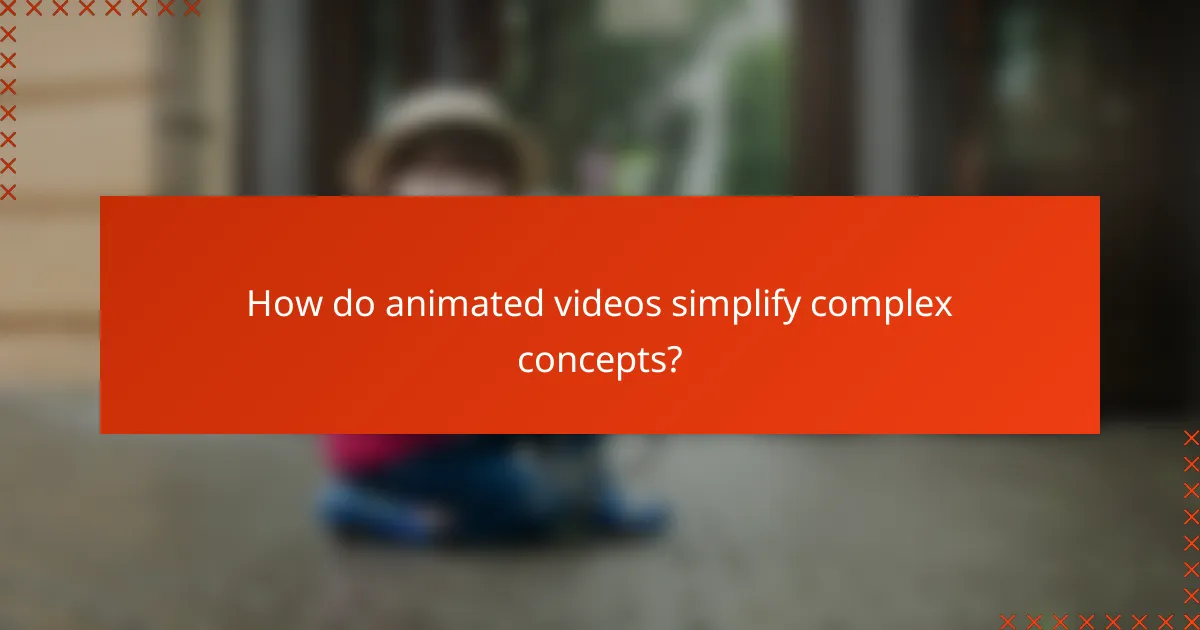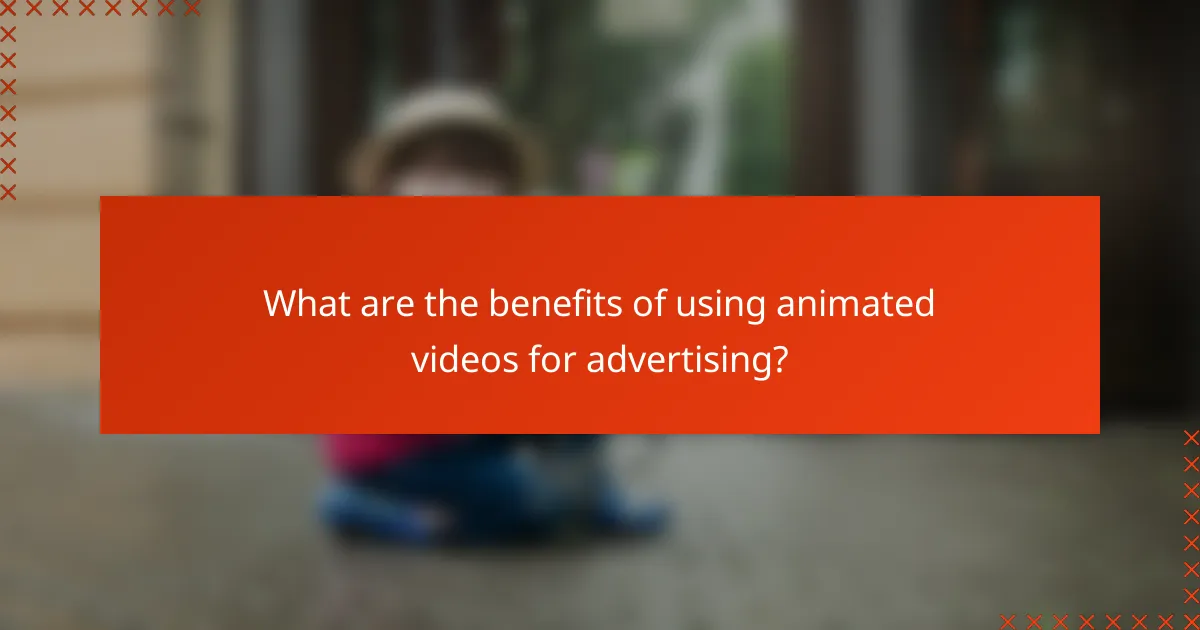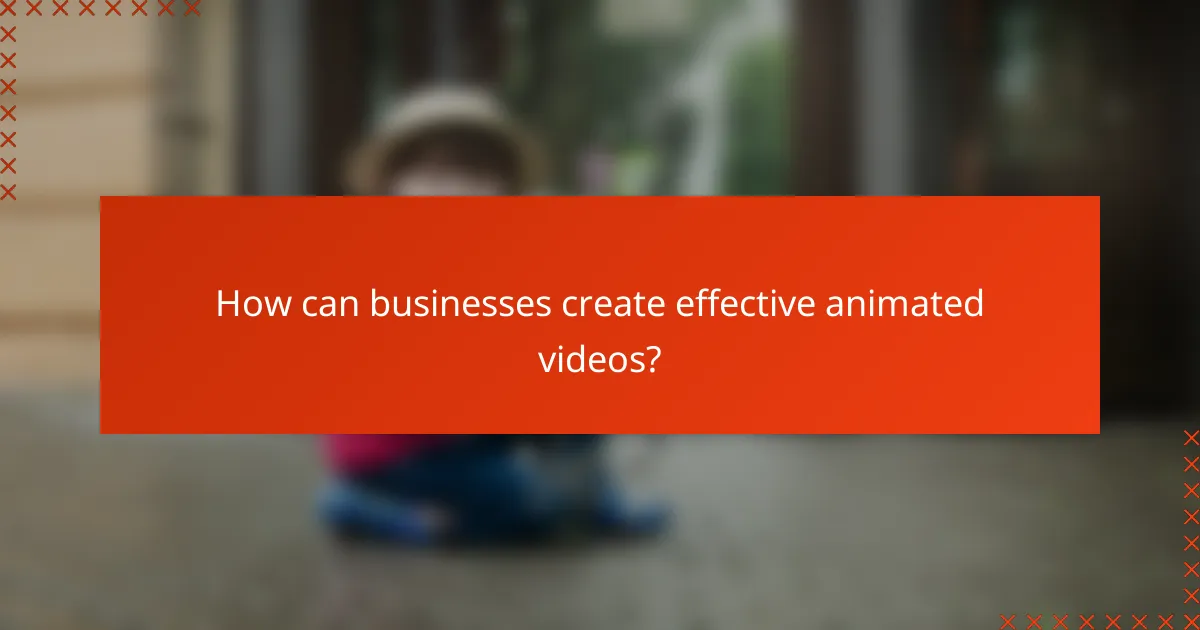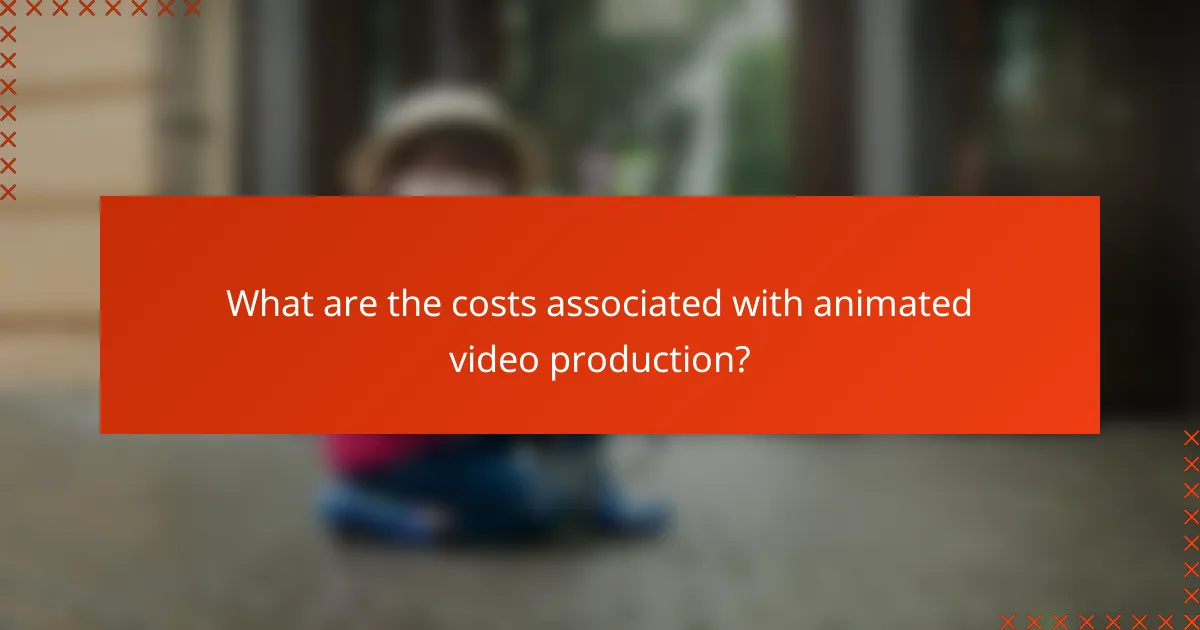Animated videos are a powerful tool for simplifying complex concepts through engaging visuals and storytelling. By breaking down information into easily digestible parts, they enhance understanding and retention while appealing to a broad audience. Their versatility makes them particularly effective in advertising, allowing brands to convey messages clearly and creatively.

How do animated videos simplify complex concepts?
Animated videos simplify complex concepts by using visual elements to break down information into digestible parts. They engage viewers through storytelling and appealing graphics, making it easier to understand and retain intricate ideas.
Visual storytelling techniques
Visual storytelling techniques leverage imagery, motion, and narrative to convey messages effectively. By combining visuals with a storyline, these techniques help viewers connect emotionally and intellectually with the content. For instance, using metaphors and analogies in animations can clarify abstract concepts by relating them to familiar situations.
Animations can illustrate processes step-by-step, allowing viewers to follow along easily. This method is particularly useful in fields like education and training, where complex subjects need to be taught in an engaging manner.
Engaging animations
Engaging animations capture attention through vibrant colors, dynamic movements, and relatable characters. These elements not only attract viewers but also enhance their focus on the message being delivered. For example, a character navigating a challenge can personify a problem, making it more relatable and easier to understand.
Additionally, incorporating humor or surprise elements can keep the audience interested, encouraging them to watch the entire video. This engagement is crucial for maintaining viewer interest, especially in a world filled with distractions.
Clear messaging
Clear messaging is essential in animated videos to ensure that the audience grasps the intended concepts without confusion. Using concise language and straightforward visuals helps eliminate ambiguity. For example, bullet points or simple diagrams can summarize key ideas effectively.
It’s important to avoid overcrowding the animation with too much information. Stick to one main idea per video, and use supporting visuals to reinforce that idea. This approach helps viewers retain information better and reduces cognitive overload.

What are the benefits of using animated videos for advertising?
Animated videos provide a dynamic way to convey messages, making them highly effective for advertising. They simplify complex concepts, engage viewers, and can be tailored to various audiences, enhancing overall marketing efforts.
Increased engagement rates
Animated videos capture attention more effectively than static content. Their vibrant visuals and storytelling elements can lead to significantly higher engagement rates, often exceeding traditional formats by a notable margin.
To maximize engagement, consider using eye-catching animations and relatable characters. Shorter videos, typically around one to two minutes, tend to perform better in keeping viewers interested.
Higher retention of information
Viewers are more likely to remember information presented through animated videos compared to text or images alone. The combination of visuals and audio helps reinforce key messages, leading to improved recall.
Incorporating storytelling techniques and clear visuals can enhance retention. Aim for a balance between entertainment and information to ensure that the audience not only watches but also remembers your message.
Wider audience reach
Animated videos can appeal to diverse demographics, making them suitable for various markets. Their universal language of visuals allows brands to connect with audiences across different cultures and age groups.
When creating animated content, consider localizing your message to resonate with specific audiences. This could involve adjusting themes, humor, or references to align with cultural norms, thereby expanding your reach effectively.

What types of animated videos are popular in the advertising industry?
In the advertising industry, popular types of animated videos include explainer videos, product demos, and social media animations. Each type serves a unique purpose, helping brands convey messages effectively and engage audiences.
Explainer videos
Explainer videos are short, engaging clips that simplify complex ideas or concepts. Typically lasting between one to two minutes, they focus on a specific problem and present a solution, often using a combination of visuals and narration.
When creating an explainer video, consider your target audience and the key message you want to convey. Use clear visuals and a straightforward script to maintain viewer interest. A common pitfall is overloading the video with information; keep it concise and focused.
Product demos
Product demos showcase how a product works and highlight its features and benefits. These videos can range from one to five minutes, depending on the complexity of the product and the details you wish to include.
To create an effective product demo, focus on the user experience and demonstrate real-life applications. Avoid technical jargon that may confuse potential customers. A good practice is to include customer testimonials or case studies to build credibility and trust.
Social media animations
Social media animations are short, eye-catching videos designed for platforms like Instagram, Facebook, and TikTok. These clips typically last between 15 to 60 seconds and aim to capture attention quickly, often using vibrant colors and dynamic movements.
When producing social media animations, tailor the content to fit the platform’s audience and format. Use engaging visuals and a strong call to action to encourage shares and interactions. Remember to keep the message simple and direct, as viewers often scroll quickly through their feeds.

How can businesses create effective animated videos?
Businesses can create effective animated videos by understanding their audience, selecting an appropriate animation style, and crafting a compelling script. These elements work together to ensure that the video communicates the intended message clearly and engages viewers effectively.
Define target audience
Identifying the target audience is crucial for creating animated videos that resonate. Consider demographics such as age, interests, and professional background to tailor content that appeals directly to viewers. For example, a video aimed at young adults may use vibrant colors and trendy music, while one for professionals might adopt a more subdued tone.
Conducting surveys or analyzing existing customer data can provide insights into what your audience values. This understanding will guide your messaging and visual style, ensuring relevance and engagement.
Choose the right animation style
The animation style should align with the brand’s identity and the message being conveyed. Options include 2D animation, 3D animation, stop motion, and whiteboard animation, each offering unique advantages. For instance, 2D animation is often more cost-effective and quicker to produce, while 3D animation can provide a more immersive experience.
Consider the complexity of the concepts being illustrated. Simpler ideas may benefit from straightforward 2D animations, while intricate subjects might require more detailed 3D representations. Always keep the audience’s preferences in mind when selecting a style.
Focus on a strong script
A strong script is the backbone of any effective animated video. It should clearly outline the key messages and maintain a logical flow. Start with a hook to grab attention, followed by a concise explanation of the main points, and conclude with a strong call to action.
Keep the language simple and engaging, avoiding jargon unless it is familiar to the audience. Aim for a script length that fits within a typical viewing time of one to three minutes, ensuring that the content remains digestible and impactful.

What tools are available for creating animated videos?
Several tools are available for creating animated videos, each offering unique features and capabilities. Depending on your needs, you can choose from professional-grade software to user-friendly platforms that cater to various skill levels.
Adobe After Effects
Adobe After Effects is a powerful software widely used for creating complex animations and visual effects. It allows users to manipulate graphics and video with precision, making it ideal for professionals seeking high-quality results.
When using After Effects, consider its steep learning curve and the need for a subscription, which typically costs around $20 to $50 per month. However, the extensive library of plugins and templates can enhance your projects significantly.
Vyond
Vyond is a web-based platform designed for creating animated videos quickly and easily, targeting businesses and educators. It offers a user-friendly interface with drag-and-drop functionality, making it accessible for beginners.
With Vyond, you can choose from various templates and characters, allowing for customization without needing advanced skills. Subscription plans range from approximately $49 to $89 per month, depending on the features you require.
Animaker
Animaker is another online tool that simplifies the animation process, focusing on creating engaging videos for marketing and educational purposes. It provides a library of pre-animated characters and scenes, making it easy to produce content quickly.
Animaker offers a free tier with limited features, while paid plans start around $19 per month. This makes it a cost-effective option for small businesses or individuals looking to create animated content without a significant investment.

What are the costs associated with animated video production?
The costs of animated video production can vary significantly based on factors such as the complexity of the project, the experience of the creators, and the production method used. Generally, you can expect expenses related to freelancer rates, agency pricing, and software subscriptions.
Freelancer rates
Freelancers typically charge based on their skill level and the project’s requirements. Rates can range from around $25 to $150 per hour, depending on the animator’s experience and the animation style. For simpler projects, a flat fee might be negotiated, which could be anywhere from a few hundred to several thousand dollars.
When hiring freelancers, consider their portfolio and client reviews to ensure quality. Clear communication about your vision and budget can help avoid misunderstandings and additional costs.
Agency pricing
Agencies usually offer a more comprehensive service, which comes at a higher price point. Costs can start from $3,000 for basic animations and can exceed $20,000 for more intricate projects. This pricing often includes scriptwriting, storyboarding, and multiple revisions.
Choosing an agency can provide a more streamlined process and access to a team of experts. However, ensure you understand what is included in the package to avoid unexpected expenses.
Software subscription costs
Animation software can also contribute to overall production costs. Popular tools like Adobe After Effects or Toon Boom Harmony typically require monthly subscriptions, ranging from $20 to $80 per month. Some platforms offer one-time purchase options, but these can be more expensive upfront.
When selecting software, consider your team’s experience and the specific needs of your project. Investing in the right tools can enhance the quality of your animations and streamline the production process.



